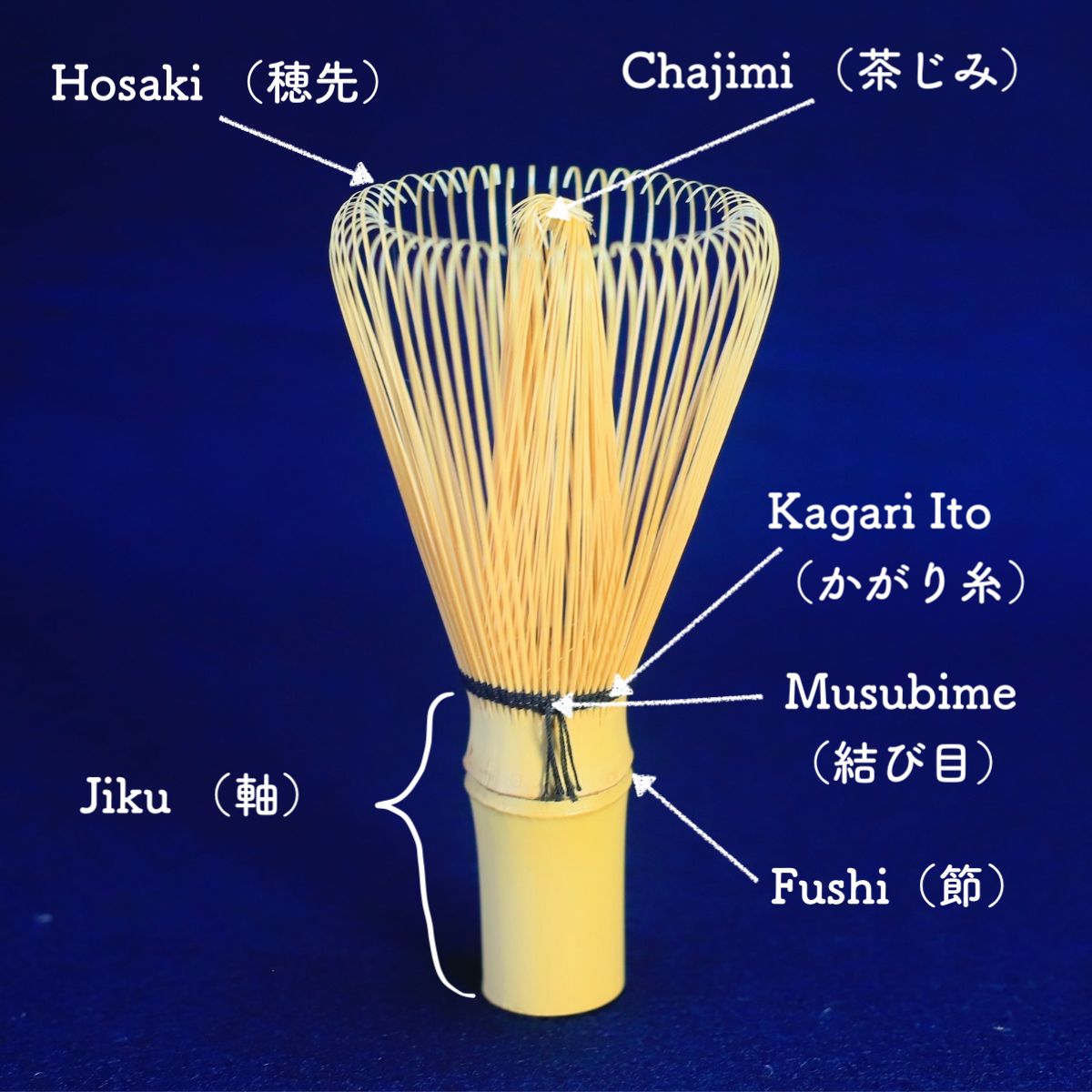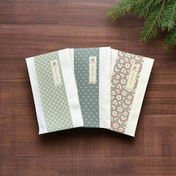This article covers the Japanese terminology for the main parts of a chasen (the bamboo whisk used to make matcha). While the terminology for the parts of chasen are in Japanese, we hope that it will help you to familiarize yourself more with the chasen or to (re)appreciate certain aspects. Some parts are more elaborated on than others. At the end we also include frequently asked questions on chasen.
The parts of a chasen
Hosaki (Japanese: 穂先)
The tines, prongs or teeth of the chasen. In general, chasen have approximately 80 - 120 prongs. However, the number of prongs can differ quite extensively with the minimum being about 16 tines. More tines means a chasen is more fine and delicate, contributing to a smoother matcha. It also means it’s easier to make foam, which we will elaborate on below. In the FAQs section of this article, we elaborate on the differences between the different number of prongs.
Chajimi (茶じみ)
One could refer to the chajimi as the bundle of prongs in the center of the chasen. Think of the hosaki as the outer circle prongs and the chajimi as the inner (bundle) prongs.
Though we have not tried it ourselves, one blogger decided to cut off the chajimi of a chasen to experiment if she could still make matcha. She found that she could still whisk matcha without the chajimi center piece, but there was a difference in the flavor of the matcha. Chajimi plays a key role in mixing the matcha powder with hot water.
Kagari-ito (かがり糸/からみ糸)
In Japanese, kagari-ito or karami-ito (rough English translation: knitting yarn), the string holding the tines at their base. Most chasen are woven with black cotton thread. This is because black thread is the least likely to show stains after making matcha.
 Black is the standard color of the kagari-ito. The rainbow color is one of my favorites from Suikaen (Tanimura Yasuburo: Seven Colored Chasen Shin Matcha Whisk).
Black is the standard color of the kagari-ito. The rainbow color is one of my favorites from Suikaen (Tanimura Yasuburo: Seven Colored Chasen Shin Matcha Whisk).
While black is the standard color, depending on the school or taste, the string may also be white or red. Schools that use white string include Sekishu-ryu, Oda Yuraku-ryu, Machida-ryu, Enshu-ryu, and Hosokawa Sansai-ryu. With the passing of time, schools have also changed the color of their karami-ito. To give an example, the Sekishu-ryu school may use navy blue thread, and the Enshu school uses black thread. Red thread and the combination of red and white threads have been used for celebrations for quite a long time. Red threaded chasen and red tea towels are also used at tea parties to celebrate sixtieth birthdays. Although we cannot confirm this, we have been told that yellow threaded chasen are used for Buddhist ceremonies.
If you are familiar with Suikaen's takayama chasen, you may also be aware of the karami-ito being other colors than black, white and red. This seems to be more of a modern trend. It is said these ideas began roughly 30~40 years ago when a class of foreigners belonging to the Urasenke school ordered a tea whisk (from Tango Tanimura) that was woven in green, white, and red for a Christmas party. Tanimura-san, who received such an order, was intrigued. This got him interested in possible color combinations that were possible. Special orders for the color of kagari-ito on the chasen seems to be increasing for foreign orders for the skillful craftsmen in Takayama. If you were to special order a chasen, what colors would you request for your very own unique chasen?
Musubime (結び目)
The knot in the kagari-ito (thread). If you are particular about directionality, you're in luck because the chasen has a direction. The side with the musubime is the front and should be facing you.
Jiku (軸)
The part that we hold to whisk the matcha. In Japanese, jiku means axis. In the context of a chasen, the jiku refers to the bamboo handle.
Fushi (節)
Refers to the slightly protruding, naturally occurring junction (node) between 2 sections of bamboo.
In this blogpost, we spent some time becoming familiar with the different parts of a chasen. In the next one, I will go over the chashaku, the very skinny and delicate matcha tea scoop that is also made out of bamboo. To wrap up today’s post, below are some frequently asked questions on chasen. I hope the information will be helpful!
FAQs on Chasen
Q: What is the standard for replacement?
The chasen has a surprisingly long lifespan. However, if the tip starts to break, that is a good indicator of a good time to replace it.
Q: Is it possible to repair the chasen?
You may have a chasen that holds a very special meaning to you. Yet, if the tip of the chasen breaks or the handle has a crack in it, it is impossible to repair it.
Please note that since the material is bamboo, it may crack due to dryness or sudden temperature changes. Additionally, if you leave it in a damp place, mold will grow (this is more likely in humid/moist places like Japan). Please make sure to store your chasen in a shaded and cool location with optimal ventilation.
Q: What is the difference between different numbers of prongs?
A chasen can have a wide range of prongs (approximately 16 ~ 120). Among chasen whisks, 70 prongs is considered to be the standard and most common. With more prongs, the easier it will be to create foam. However, because a chasen is made by splitting a single piece of bamboo, the disadvantage will be that with greater number of prongs, the thicker the handle will be which makes it challenging to hold when one goes to whisk their matcha.
A whisk with approximately 80~100 prongs is recommended for beginners. Below is a table which depicts the differences between chasen based on the number of prongs. Each has its own characteristics and uses.

Q. How do you care / clean a chasen?
With respect to caring for your chasen, keep in mind that it is made of bamboo. Think of the whisk as being raw. Mold may grow, it may also break. When handling the whisk to prepare matcha and cleaning it afterwards, handle as gently as possible. The prongs of a chasen are especially delicate and vulnerable so you want to be extra careful when handling. Of course, all chasen should be treated with tender loving care. And if you own a hand-made Takayama chasen, remember that a craftsman has made your chasen with their beautiful craftsmanship. We hope that you will treat your chasen with honor and respect.
Some tips before using a new chasen
Before using your brand new chasen for the very first time, please wash it lightly with water. Fill a bowl or container with enough water so that you can carefully and gently shake the prongs in the water. It is best to avoid using water directly from the faucet because this may splash water into the base of the chasen and contribute to mold growth.
Aftercare for your chasen
Perhaps the most important point is to wash the chasen as soon as possible after use. As stated previously, it is best NOT to use water directly from the faucet, instead wash the chasen in a bowl with lukewarm water inside. It is okay to gently rub the prongs with your fingers (e.g., to take stains off from the matcha), but the key is to BE GENTLE! When cleaning your whisk, please do not use sponges or detergents. The drying process is important as well because if water is left, mold may grow. A well-ventilated and shady location is the best for drying. You may wipe the handle of the whisk with a clean towel. Ideally, other parts should be left to dry naturally.
How to store your chasen with care
When one utilizes a chasen for a long time, the shape will inevitably become thinner (see image below).
 The above are both chasen that are quite old (owned by my grandmother who has passed) but you can see that the one to the right has become quite narrow.
The above are both chasen that are quite old (owned by my grandmother who has passed) but you can see that the one to the right has become quite narrow.
When the chasen is stored upright with the prongs facing upward, the tips of the whisks will naturally become narrower. The good news is, one can make the beautiful shape of the chasen last longer by storing it on a dedicated chasen holder. In Japanese, these are called “kuse naoshi” or “chasen yasume” which translates to something along the lines of “habit fixer” and “whisk rester”.
 Left: Stunning glass chasen holder by Suikaen. There are also nice simple ones like the shown to the right (Modern whisk stand).
Left: Stunning glass chasen holder by Suikaen. There are also nice simple ones like the shown to the right (Modern whisk stand).
Of course, not everyone can afford one and/or may not feel the necessity to purchase a chasen holder. That is completely okay; however, please DO NOT store it in the plastic container that it may have come in. Once the whisk is used, it is a bad idea to restore it in this type of container as there is zero ventilation. Perhaps, the only time you may consider restoring it in its original plastic container may be when you would like to transport your chasen for a short period of time.
 Basic Matcha Bamboo Whisk Chasen (120-prong) from Yunomi Tea. Image shows the plastic container that you should not store your chasen in once it is used!
Basic Matcha Bamboo Whisk Chasen (120-prong) from Yunomi Tea. Image shows the plastic container that you should not store your chasen in once it is used!
Q. What is the difference between Japanese and Chinese chasen?
Chasen made in Japan and China differ across various points. One of the major differences, apart from the price (which tends to be the focus of consumers) lies in its quality. While both are made from bamboo, they undergo a very different process in their making. For instance, the chasen makers in Takayama, Nara Prefecture will harvest the bamboo and wait 2~3 years for the bamboo to dry completely before they start to make the actual chasen. In comparison, chasen made in China and overseas are often mass produced. Hence, the bamboo is harvested but there is no waiting period. They harvest the bamboo and bleach the bamboo to change the color of bamboo, so that they will look like the Japanese ones (which obtains their color from the natural drying process). The harvested chasen is also not completely dry but pesticide may be sprayed to ensure the bamboo is not damaged by insects. Desiccant beads are often placed in the packaging alongside the chasen in the plastic box. If you would like to learn more about the craftsmanship of the chasen making process in Japan, please read: The Art of Chasen Making.
Foreign-made chasen are recommended for those who value cost performance. For those looking for quality, chasen from Takayama in Nara Prefecture is highly recommended. If you need help in selecting a chasen, please check out our other blogpost: Looking for a matcha whisk? Here are some tips.


